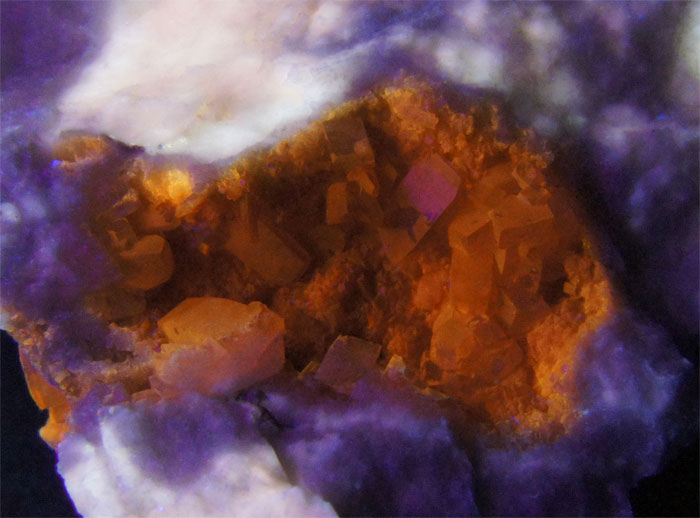Database of luminescent minerals
PREHNITE
Chemical formula: Ca2Al2Si3O10(OH)2
Family: Silicates
Status: IMA-GP
Crystal system : Orthorhombic
Display mineral: NON
Luminescence:
Longwave UV (365nm) colors: |
Yellowish White , Orange , | ||
Midwave UV (320nm) colors: |
Pale Yellow , | ||
Shortwave UV (254nm) colors: |
Bluish White , White , Yellowish White , Pale Yellow , Orange , | ||
Daylight picture

Longwave (365nm) picture

Prehnite UVLW, Jeffrey Mine, Asbestos, Qu�bec, Canada;
Col. G. Barmarin; Photo: G. Barmarin
Shortwave (254nm) picture

Prehnite UVSW, Jeffrey Mine, Asbestos, Qu�bec, Canada;
Col. G. Barmarin; Photo: G. Barmarin
Pictures Galery:



 ...
...Do you have a photo of this mineral you would like to see in the gallery? Contact us!
Phosphorescence (in the common sense of the term) observable with the naked eye:
No data
Activator(s) and spectrum:
Activator(s): Pb2+,
Peaks in the spectrum (nm):
Pb2+ : 356nm (exc. 266nm, t = 300ns)

Spectrum: Michael Gaft, Petah Tikva, Israel. Plot: Institute of Mineralogy, University of Vienna, Austria, with permission of the authors.
Comments on spectrum and activators:
Jeffrey Mine: bluish fluorescence under long wave UV illumination, plus orange-fluorescing coating by an unknown mineral (see picture above)
Best localities for fluorescence (*):
- Franklin Mine, Franklin, Franklin Mining District, Sussex County, New Jersey, USA;
- Jeffrey Quarry, Asbestos, Shipton Township, Richmond Co., Québec, Canada;
- Jeffrey Mine, Asbestos, Les Sources RCM, Estrie, Québec, Canada;
- Ilimaussaq complex, Kvanefjeld, Narsaq, Kitaa (West Greenland) Province, Greenland;
- Taza, Taza Province, Taza-Al Hoceïma-Taounate Region, Morocco (dull luminescence SW+LW);
- Near Langban, Sweden (SW White);
(*)The data are not exhaustive and are limited to a few remarkable localities for fluorescence
Bibliographic reference for luminescence:
- The Henkel Glossary of Fluorescent Minerals, Dr. Gerhard Henkel, Published by the FMS, 1989 ,
- Fluorescence: Gems and Minerals Under Ultraviolet Light, Manuel Robbins, 1994, Geoscience Press, ISBN 0-945005-13-X ,
- The World of Fluorescent Minerals, Stuart Schneider, Schiffer Publishing, 2006, ISBN 0-7643-2544-2 ,
- Luminescence Spectroscopy of Minerals and Materials, M. Gaft, R. Reisfeld, G. Panczer, Springer Editor, ISBN: 10 3-540-21918-8 ,
Reference for luminescence on the Internet:
- Der Aufschluss, Vol.48, n°2 March/April 1997 Langban minerals by Fritz Blatter;
Images:
- Jeffrey Mine, Canada: http://www.mindat.org/photo-513596.html
- Franklin Mine, New Jersey, USA: https://www.mindat.org/photo-343678.html
- http://www.nightsea.com/does-it-fluoresce/mineral-fluorescence-blue-light-prehnite-and-pectolite/
Mineralogical reference on the Internet:
 http://www.mindat.org/show.php?name=Prehnite
http://www.mindat.org/show.php?name=Prehnite
 http://webmineral.com/data/Prehnite.shtml
http://webmineral.com/data/Prehnite.shtml
Internet Search:
 Image search on 'Google Images'
Image search on 'Google Images'
 Search for documents in all languages on Google
Search for documents in all languages on Google
A request providing no result means only that no such reference exists in the database, but it does not mean that what you are looking for does not exist, just not to our knowledge. If you think you have found an error or omission, please let us know via the contact page being sure to cite the source of information.

